In my previous blog, I introduced the notion that humans, like insects and mollusks, may also be the subjects of involuntary behavioral control resulting from parasitic infection. May I now introduce Toxoplasma, a leading candidate for such a human behavior manipulator? 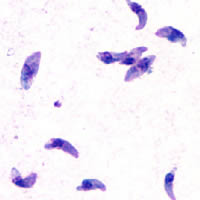
Toxoplasma is a protozoan, one of the vast Kingdom of single-celled creatures that swarm in the earth’s waters, soils, and yes – within other organisms. Many of you, although you may not know its name, have heeded warnings about Toxoplasma exposure. This is the parasite often found in cat feces and thus the admonitions to be careful when cleaning your cats’ litter box. This is particularly true for pregnant women as the parasite can be transmitted to the fetus with potentially dangerous results. Infection with this protozoan is known as toxoplasmosis and it is  common in a variety of mammals. These include cats, rodents, pigs, and humans. By some estimates, nearly thirty percent of the world’s human population is infected with Toxoplasma. Normally the protozoan, after causing initial flu-like symptoms, resides in the human body without further affect – or so it was thought.
common in a variety of mammals. These include cats, rodents, pigs, and humans. By some estimates, nearly thirty percent of the world’s human population is infected with Toxoplasma. Normally the protozoan, after causing initial flu-like symptoms, resides in the human body without further affect – or so it was thought.
I had been aware for some time of the hijacking of the behavioral instincts of rats by Toxoplasma. Since rats are a potential prey of cats, it makes sense that they would serve as a link in the completion of the parasites’ life cycle. It seems a cycle such as: protozoan reproduces in cat – protozoan in cat feces – feces in soil – accidental ingestion of protozoan by rat – cat eats rat – would be straightforward enough. But, here again, we are dealing with the strange world of behavioral manipulation by a parasite. Studies have shown that the rat is programmed by Toxoplasma to engage in behavior which makes the rodent much more likely to be eaten by a cat. In other words, the parasite guides rodent behaviors which will increase the likelihood of its return to the gut of a cat host. Here it can reproduce and continue the completion of its life cycle. 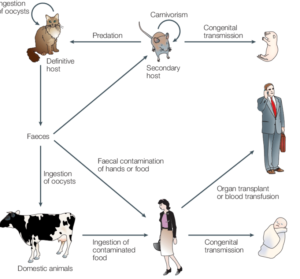
For obvious reasons, rats are normally extremely averse to having a meeting with a cat. When these rodents are infected with Toxoplasma however, their behavior changes dramatically. They are more prone to actively expose themselves and their reaction to danger is slowed. Normally, a rat smelling cat urine responds by freezing, analyzing its surroundings, and then scurrying for cover. Rats harboring Toxoplasma do the exact opposite. They seem to actually be attracted to cat urine and are quite content to ignore their instinct to avoid a meeting with their feline nemesis. Research suggests that, upon exposure to cat urine, Toxoplasma is actually biochemically activating a part of the rat brain associated with sexual attraction. This powerful urge then overrides the rat’s inclination to flee from signs of the presence of a predator. In other words, Toxoplasma is altering the behavior of the rat in order to make it more likely that a cat will ingest the parasite and thus will the protozoan be transmitted to other feline hosts.
Could Toxoplasma be causing behavioral changes in humans sheltering the parasite? An article by Kathleen McAuliffe which appeared in The Atlantic in 2012* certainly seems to suggest as much. Recall that most people infected with this parasite experience it in its so-called latent form. After the initial flu-like reaction, it was thought to lie quietly in the neurons of our brain without harm. Some scientists now suspect that Toxoplasma is not such a benign resident. This was the gist of McAuliffe’s article which profiled a Czech biologist, Jaroslav Flegr, who was himself infected with Toxoplasma. For many years Flegr was puzzled by some aspects of his behavior. He reported in the interview with McAuliffe that he thought nothing of walking into a busy, traffic-filled street. Honks of irritation from oncoming  motorists he met with total indifference. Furthermore, he openly criticized the ruling Communist Party, a most dangerous endeavor at that time. Doing research in a war torn area of Turkey, he was surprised that his reaction to nearby gunfire was complete lack of distress and absence of any instinct to take cover. All of these behaviors bore an uncanny resemblance to the daredevil antics of a rat with toxoplasmosis.
motorists he met with total indifference. Furthermore, he openly criticized the ruling Communist Party, a most dangerous endeavor at that time. Doing research in a war torn area of Turkey, he was surprised that his reaction to nearby gunfire was complete lack of distress and absence of any instinct to take cover. All of these behaviors bore an uncanny resemblance to the daredevil antics of a rat with toxoplasmosis.
After reading articles regarding parasitic mind control among invertebrates, Flegr began to suspect that he might be similarly affected. He had himself tested and discovered that he did indeed have toxoplasmosis. We should think of humans as a dead end in this parasite’s life cycle (cats usually don’t eat humans). However, we are similar enough in genetic and physiological makeup to other mammals that it seems reasonable to assume that Toxoplasma might not “know” the difference. Pursuing this line of reasoning, Flegr’s investigations revealed that humans infected with Toxoplasma showed inattentiveness and delayed reaction times as do infected rodents. His research showed that certain drivers, as a result, were nearly twice as likely to be involved in vehicular accidents if they carried the latent Toxoplasma. Perhaps even more disturbing, science is suggesting that Toxoplasma may be involved in triggering schizophrenia in susceptible humans. Furthermore, a 2012 Scientific American article reports that researchers now also suspect a link between toxoplasmosis and an increased risk of suicide. 
I find the thought that parasitic infection could cause such serious psychological manifestations among us humans quite alarming. One cannot help reexamining the extensive list of endoparasites which make humans their home – roundworms, tapeworms, flukes, protozoans. In the process, we are left to wonder just how many other neuroses or psychotic manifestations of Homo sapiens may someday be traced to our eerily creepy stealth attackers.
* https://www.theatlantic.com/magazine/archive/2012/03/how-your-cat-is-making-you-crazy/308873/
Postscript:
I recently became aware of another possible actor in the drama of parasitic mind control. I was reading Oliver Sacks’ fascinating book, The Man Who Mistook His Wife for a Hat and Other Clinical Tales. In his book Sacks, who was a neurologist for almost five decades, recounts case histories of patients with peculiar, often bizarre neurological disorders.
One of his patients was a 90 year old woman named Natasha. She came to Dr. Sacks after noticing a change in her behavior which had begun when she was 88. The doctor, of course, inquired as to what sort of change she had noticed. “Delightful!” she exclaimed. “I thoroughly enjoyed it. I felt more energetic, more alive – I felt young once again. I took an interest in the young men. I started to feel, you might say, frisky – yes, frisky.”
In the course of receiving Natasha’s medical history Dr. Sacks found that she had worked in a brothel over 60 years ago. She revealed that, like 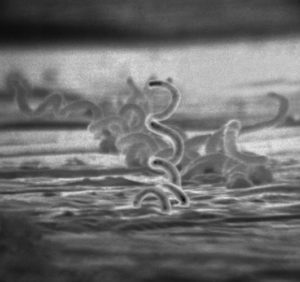 most of her coworkers, she had acquired syphilis during this time. As you know, this is a highly contagious, sexually transmitted disease caused by a bacterium named Treponema pallidum. This bacterium is a type of spirochete, so-called because of its helically spiraled shape.
most of her coworkers, she had acquired syphilis during this time. As you know, this is a highly contagious, sexually transmitted disease caused by a bacterium named Treponema pallidum. This bacterium is a type of spirochete, so-called because of its helically spiraled shape.
The disease syphilis typically occurs in stages. The so-called tertiary stage may occur years after the initial infection. Although not infective at this time, the victim may experience serious symptoms such as loss of muscle control, depression, mania, and dementia. Death may ensue.
Natasha described her illness as, “something in my body, my, brain that was making me high.” To Dr. Sacks’ surprise, she then self-diagnosed herself as having “Cupid’s Disease”, a term with which he was unfamiliar. “All the girls called it that,” she said. The doctor proceeded to test her spinal fluid. “She was right; the spinal fluid was positive, she did have neurosyphilis, it was indeed the spirochetes stimulating her ancient cerebral cortex.”
I have as yet found no clinical studies affirming that Treponema increases promiscuity or the libido of its host (as in Natasha’s case). But in light of the impact of Toxoplasma on human behavior (as described above), it seems a possibility. After all, what better way could the syphilis bacterium ensure continued species survival than by making its human host feel – shall we say frisky?
Photo Credits: Cat and pregnant women courtesy of findatopdoc.com People ignoring danger courtesy of upsplash.com The Scream by Edvard Munch via Wikimedia Commons [Public domain, Toxoplamosis gondii courtesy of The Center for Disease Control Toxoplasmosis life cycle courtesy of researchgate.net syphilis bacterium by Dr. David Cox @ en.wikipedia.org

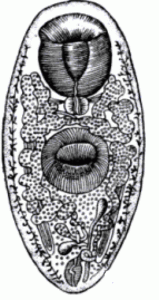 Leucochloridium parasitizes birds. The big problem faced by Leucochloridium, and parasites in general, is how to get from one host to another. Endoparasites are highly and specifically adapted for surviving in the warm, dark, nutrient rich innards of their host. They are not built to function in what for them is the hostile outer world we humans inhabit. Here the atmosphere is highly oxygenated, there is intense sunlight, and ambient temperatures are highly variable. Yet, to continue their species, they must find a way to insinuate their adult progeny into the internal organs of another host.
Leucochloridium parasitizes birds. The big problem faced by Leucochloridium, and parasites in general, is how to get from one host to another. Endoparasites are highly and specifically adapted for surviving in the warm, dark, nutrient rich innards of their host. They are not built to function in what for them is the hostile outer world we humans inhabit. Here the atmosphere is highly oxygenated, there is intense sunlight, and ambient temperatures are highly variable. Yet, to continue their species, they must find a way to insinuate their adult progeny into the internal organs of another host.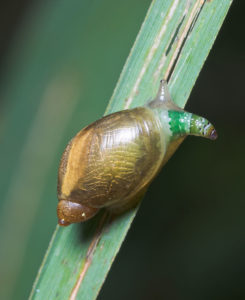 banded, animated appearance bears a remarkable resemblance to a caterpillar. Of course caterpillars are a favorite food of many bird species. And remember, these puffed-up tentacles are packed with fluke larvae very much needing to get into a bird.
banded, animated appearance bears a remarkable resemblance to a caterpillar. Of course caterpillars are a favorite food of many bird species. And remember, these puffed-up tentacles are packed with fluke larvae very much needing to get into a bird.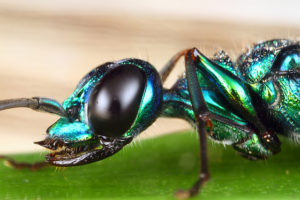 than an inch) wasp with a beautiful metallic greenish-bluish body color. And, it does indeed parasitize cockroaches. As you might guess, it is the manner in which it does so that is dumbfounding.
than an inch) wasp with a beautiful metallic greenish-bluish body color. And, it does indeed parasitize cockroaches. As you might guess, it is the manner in which it does so that is dumbfounding.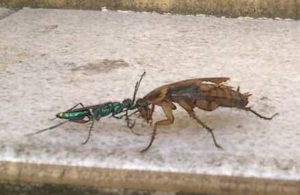 antennae with its jaws, the wasp leads its host to a previously prepared burrow in the ground. Like a well-trained dog on a lead, the cockroach obediently allows itself to be ushered, by the wasp, down into its own tomb.
antennae with its jaws, the wasp leads its host to a previously prepared burrow in the ground. Like a well-trained dog on a lead, the cockroach obediently allows itself to be ushered, by the wasp, down into its own tomb.